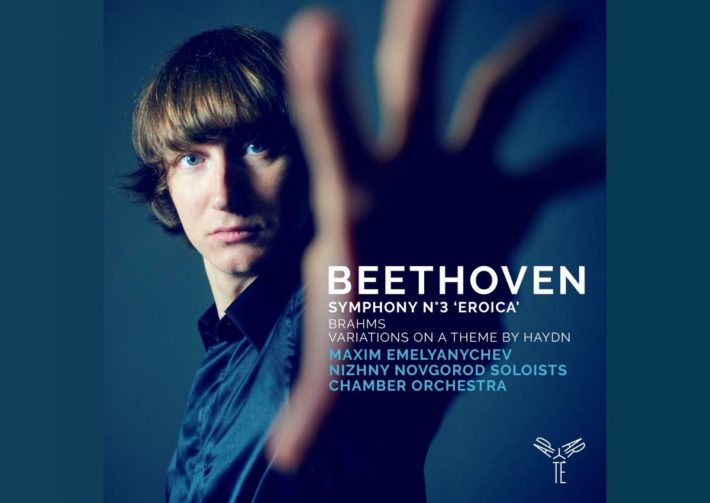With hundreds of recordings of Beethoven Symphony No. 3 (“Eroica”), you better have something new to bring to the table, not to mention some courage. Maxim Emelyanychev is already rather known for his work with the period-instrument ensemble Il Pomo d’Oro, or his chamber and solo recordings, also on period instruments. This time around he conducts the ”Nizhny Novgorod Soloists Chamber Orchestra” (in Russian: Солисты Нижнего Новгорода), with what sounds like period interments, though not specified in the release (maybe “historical awareness” has become so common that it needn’t be mentioned?). In any case, all the hallmarks of a well trained, nicely blended period ensemble are here: modestly sized and lean-sounding strings, rusty brass section, sharp, woody timpani and soft sounding woodwind.
It’s easy for this period inspired an approach to sound aggressive, or too “punchy” in the many accents specified in the fast movements, and happily, they are very well projected here without sounding too forceful (12:52 in the first movement). It’s one of the many treats this performance entails – an ability to pronounce the musical argument with clarity, not with forcefulness. Listen for instance to the lower voices line so heavily emphasized on other performances, here given at a whisper volume level, but not less effective (14’38”).
The Funeral March is expertly done – building the climaxes confidently. But it’s the less obvious highlights that are more impressive. Time and again some hidden jams jump out from the score, and mainly coming from the woodwind and brass sections – Listen, for instance, right after the main climax of the march, how well all the groups blend together and articulating the return of the main subject from 9:00 onward – it will make you hear how meticulously Beethoven wrote the contrapunct in this movement. It’s rarely heard so clearly in other performances. Or, moving to the third “Scherzo” movement, the quick dialogue between strings, oboe and flute in the first bars of the movement.
Not all perfect, though. There seems to be a small difficulty handling the horns in the middle section when reaching the high notes (2:20). However, listen how the subtle slowing down when the horn group return makes a nicely rounded chord (2’55”). These small revelations are worth the admission of some blemishes, and they frankly add to the general spirit of spontaneity in this performance.
The tempo, atmosphere and overall high spirit in the finale sound just right, with the polyphony sections of this marvelous movement again clearly and expertly articulated, though without sounding too clinical. “Clarity” is indeed the best description of this Eroica version, as “energetic” best described Jordi Savall’s period version or “revolutionary” suited Gardiner’s period version. But this well-recorded, fresh version somehow combines all of those qualities.

Chamber Brahms
Maxim Emelyanychev has been selected as the Scottish Chamber Orchestra’s next Principal Conductor a few months ago, an orchestra with which their former principal conductor, Robin Ticciati, released a full cycle of the Brahms Symphonies (They did not include the “Haydn Variations”). There are still many qualms about playing Brahms with a chamber orchestra; The composer might have used such an ensemble when needed, for instance for his Meiningen debut of his Fourth Symphony. But he obviously also preferred the large size of the late 19th century Symphonic orchestra, conducting and hearing his pieces played by such large ensembles throughout his professional life. There are again some nice touches of hidden voices in some variations here as well (Var. 4), and some delicious energetic playing from the ensemble elsewhere in the faster variations. But here the small blemishes are perhaps a bit less forgivable (couldn’t the producers re-record the first theme’s missed notes and problematic intonation from 1’00” to the end of the theme?).
The climax of the finale is much less effective with a smaller, chamber orchestra, and with all the good intentions of the group, this case is not an exception I’m afraid.
In sum, this album is worthwhile for the Eroica alone. Treat the Brahms as an interesting bonus and you will not be disappointed.

Beethoven – Symphony No. 3 (“Eroica”)
Brahms – Haydn Variations
Nizhny Novgorod Soloists Chamber Orchestra
Maxim Emelyanychev – Conductor
Aparté Music, ref AP191
Follow Us and Comment:
Get our periodic classical music newsletter with our recent reviews, news and beginners guides.
We respect your privacy.










melgross
To put it quickly, and simply, I disagree with this review.
I found the 3rd to be bland, and quite frankly, boring. I couldn’t get into the music at all. I have numerous performances of this piece. This performance, as with a small few others, seems to be going for a lyrical approach. But that isn’t what this music is about. Attempting it, ruins the atmosphere that Beethoven was attempting to project.
Very disappointing.